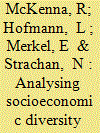|
|
|
Sort Order |
|
|
|
Items / Page
|
|
|
|
|
|
|
| Srl | Item |
| 1 |
ID:
150019


|
|
|
|
|
| Summary/Abstract |
Adequately accounting for interactions between Low Carbon Technologies (LCTs) at the building level and the overarching energy system means capturing the granularity associated with decentralised heat and power supply in residential buildings. The approach presented here adds novelty in terms of a realistic socioeconomic differentiation by employing dwelling/household archetypes (DHAs) and neighbourhood clusters at the Output Area (OA) level. These archetypes are combined with a mixed integer linear program (MILP) to generate optimum (minimum cost) technology configurations and operation schedules. Even in the baseline case, without any LCT penetration, a substantial deviation from the standard load profile (SLP) is encountered, suggesting that for some neighbourhoods this profile is not appropriate. With the application of LCTs, including heat pumps, micro-CHP and photovoltaic (PV), this effect is much stronger, including more negative residual load, more variability, and higher ramps with increased LCT penetration, and crucially different between neighbourhood clusters. The main policy implication of the study is the importance of understanding electrical load profiles at the neighbourhood level, because of the consequences they have for investment in the overarching energy system, including transmission and distribution infrastructure, and centralised generation plant. Further work should focus on attaining a superior socioeconomic differentiation between households.
|
|
|
|
|
|
|
|
|
|
|
|
|
|
|
|
| 2 |
ID:
193738


|
|
|
|
|
| Summary/Abstract |
This paper analyzes the load profiles and electricity consumption patterns of different customer types electrified by off-grid solar photovoltaic (PV) mini-grids in two remote towns in Ethiopia using metered data collected over a 20-month period and a survey of 238 customers. Findings show that the load profiles of mini-grid customers differ significantly across locations, sectors, and time. The load curves at site one (Omorate) are interrupted and completely shed off for 13 h every day due to the demand consistently exceeding the generation. By contrast, the mini-grid at site two (Tum) generates enough electricity to meet the demand continuously. The average daily electricity consumption at Omorate, 1065 kW h, is more than 1.5 times the consumption at Tum, 640 kW h; despite the fact that the mini-grid at Omorate has a significantly lower installed capacity than the one at Tum. At both sites, the monthly consumption of productive users is more than three times that of households. At both sites, demand for electricity has significantly increased over time, but at varying rates. Regression analyses showed significant differences in the factors influencing electricity consumption between the two towns. Key policy implications of the study are discussed for informed planning of rural electrification through mini-grids.
|
|
|
|
|
|
|
|
|
|
|
|
|
|
|
|
|
|
|
|
|